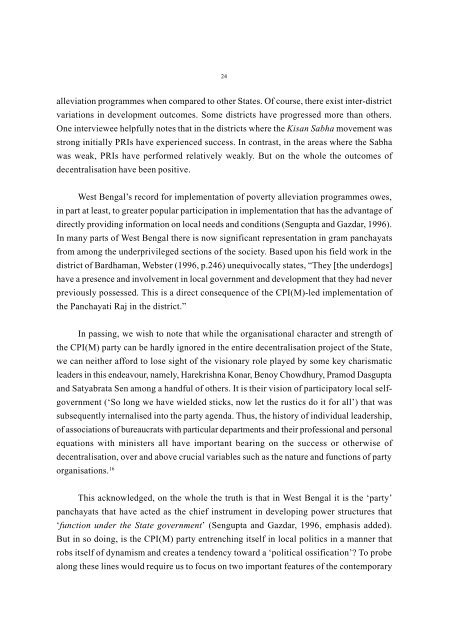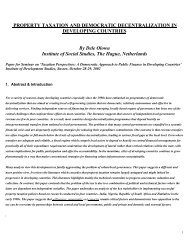View Article - Institute of Development Studies
View Article - Institute of Development Studies
View Article - Institute of Development Studies
You also want an ePaper? Increase the reach of your titles
YUMPU automatically turns print PDFs into web optimized ePapers that Google loves.
24alleviation programmes when compared to other States. Of course, there exist inter-districtvariations in development outcomes. Some districts have progressed more than others.One interviewee helpfully notes that in the districts where the Kisan Sabha movement wasstrong initially PRIs have experienced success. In contrast, in the areas where the Sabhawas weak, PRIs have performed relatively weakly. But on the whole the outcomes <strong>of</strong>decentralisation have been positive.West Bengal’s record for implementation <strong>of</strong> poverty alleviation programmes owes,in part at least, to greater popular participation in implementation that has the advantage <strong>of</strong>directly providing information on local needs and conditions (Sengupta and Gazdar, 1996).In many parts <strong>of</strong> West Bengal there is now significant representation in gram panchayatsfrom among the underprivileged sections <strong>of</strong> the society. Based upon his field work in thedistrict <strong>of</strong> Bardhaman, Webster (1996, p.246) unequivocally states, “They [the underdogs]have a presence and involvement in local government and development that they had neverpreviously possessed. This is a direct consequence <strong>of</strong> the CPI(M)-led implementation <strong>of</strong>the Panchayati Raj in the district.”In passing, we wish to note that while the organisational character and strength <strong>of</strong>the CPI(M) party can be hardly ignored in the entire decentralisation project <strong>of</strong> the State,we can neither afford to lose sight <strong>of</strong> the visionary role played by some key charismaticleaders in this endeavour, namely, Harekrishna Konar, Benoy Chowdhury, Pramod Dasguptaand Satyabrata Sen among a handful <strong>of</strong> others. It is their vision <strong>of</strong> participatory local selfgovernment(‘So long we have wielded sticks, now let the rustics do it for all’) that wassubsequently internalised into the party agenda. Thus, the history <strong>of</strong> individual leadership,<strong>of</strong> associations <strong>of</strong> bureaucrats with particular departments and their pr<strong>of</strong>essional and personalequations with ministers all have important bearing on the success or otherwise <strong>of</strong>decentralisation, over and above crucial variables such as the nature and functions <strong>of</strong> partyorganisations. 16This acknowledged, on the whole the truth is that in West Bengal it is the ‘party’panchayats that have acted as the chief instrument in developing power structures that‘function under the State government’ (Sengupta and Gazdar, 1996, emphasis added).But in so doing, is the CPI(M) party entrenching itself in local politics in a manner thatrobs itself <strong>of</strong> dynamism and creates a tendency toward a ‘political ossification’? To probealong these lines would require us to focus on two important features <strong>of</strong> the contemporary





